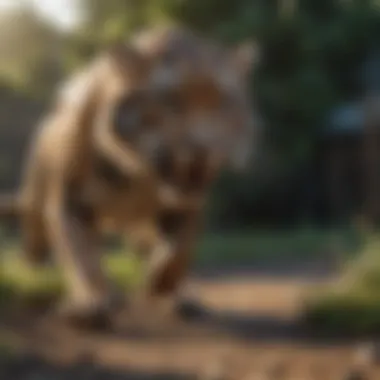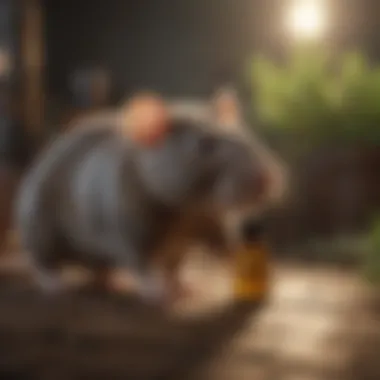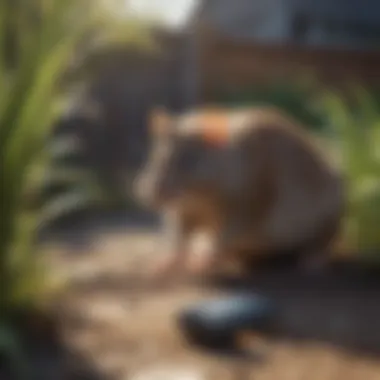Expert Strategies for Deterring Rats in Your Outdoor Space


Preventive Pest Control Strategies
Housewives looking to maintain a clean and pest-free home must prioritize preventive pest control strategies. Starting with the house's exterior, it is crucial to seal any cracks or gaps that could serve as entry points for pests. Regularly clearing debris such as fallen leaves and branches will also help eliminate potential hiding spots for rodents like rats. Additionally, implementing measures to prevent pests from entering the house, such as installing mesh screens on windows and doors, can be highly effective.
When it comes to yard maintenance, housewives should adhere to essential routines such as mowing the lawn, trimming bushes, and removing standing water sources, which can attract pests. By keeping the yard well-groomed and void of clutter, the likelihood of pest infestations, including rat populations, decreases significantly. Inside the home, prioritizing cleanliness by regularly vacuuming, sweeping, and decluttering minimizes pest attractants, ultimately creating a pest-resistant indoor environment.
Efficient garbage disposal practices are crucial in deterring rats and other pests from invading the home. Ensuring that garbage bins are tightly sealed, disposing of food scraps properly, and promptly removing trash will help eliminate potential food sources that attract rodents. Additionally, educating oneself on innovative pest prevention strategies, such as using natural repellents or deterrent plants, can further enhance the effectiveness of preventive measures and contribute to maintaining a pest-free environment.
Identifying Pest Risk Areas
To effectively combat pest infestations, housewives must be able to identify common pest risk areas within and around the home. Conducting a thorough inspection of moisture-prone areas, such as basements and crawl spaces, is essential for identifying damp conditions that may attract pests like cockroaches and rodents. Implementing measures to address moisture issues, such as fixing leaks and improving ventilation, can help prevent infestations before they escalate.
Similarly, inspecting cracks and crevices in the building structure is crucial for sealing off potential entry points for pests. By using sealants or caulking materials to fill gaps, housewives can significantly reduce the likelihood of pest intrusion. Taking a proactive approach to greenery inspection can also aid in pest prevention, as overgrown vegetation can provide shelter and food sources for pests. Maintaining a well-trimmed yard and addressing any overgrowth promptly can deter pests from residing in close proximity to the house.
In addition to these measures, being aware of other pest risk areas, such as cluttered storage spaces or areas with accumulated debris, is vital for comprehensive pest prevention. Implementing preventive measures tailored to specific risk areas can significantly lower the chances of pest infestations and contribute to a healthier living environment.
Effective Pest Control Methods
When faced with pest infestations, housewives can leverage a range of effective pest control methods to address the issue. Natural repellents, such as essential oils and herbal solutions, can serve as safe and eco-friendly alternatives to traditional chemical-based sprays. By strategically placing these natural repellents around potential entry points, housewives can deter pests without exposing their homes to harmful chemicals.
In cases where stronger intervention is necessary, chemical sprays designed for pest control can be utilized with caution. Following manufacturer instructions and safety precautions when using chemical sprays is essential to ensure effective pest eradication while safeguarding the health of household members and pets. Pest traps, including live traps and snap traps, are another effective method for capturing and removing pests, particularly rodents like mice and rats.
For those looking to adopt more sustainable pest control measures, biological control methods offer an environmentally friendly solution. Introducing natural predators or beneficial insects that feed on pests can help maintain ecological balance while mitigating pest populations. Innovative pest control methods, such as ultrasonic devices or integrated pest management strategies, provide additional options for housewives seeking long-term solutions to pest issues.
Pest Species Identification
To effectively combat pest infestations, housewives must be able to identify common pest species that pose a threat to their homes. In the realm of home pest control, recognizing and managing common insects like ants, cockroaches, and spiders is essential. By understanding the behaviors and nesting habits of these insects, housewives can implement targeted pest control measures to minimize their presence.
In addition to insect pests, rodents like mice and rats are frequent invaders of residential spaces, causing damage and posing health risks. Learning to identify signs of rodent activity, such as droppings or gnaw marks, can help housewives take swift action to prevent infestations. Addressing bird-related issues, such as bird nests near structures or bird droppings on roofs, is also important for maintaining a pest-free home environment.
Wildlife encounters, including those with raccoons, squirrels, or opossums, require specific handling techniques to ensure both human safety and wildlife conservation. Understanding the behavior and typical habitat of wildlife species can aid housewives in implementing non-lethal control measures to deter wildlife from encroaching on their property. By being vigilant and proactive in identifying various pest species and their associated risks, housewives can effectively protect their homes from infestations.
DIY Pest Control Techniques


Empowering housewives with DIY pest control solutions enables them to tackle minor pest issues effectively and sustainably. Homemade pest control remedies, using common household ingredients like vinegar, baking soda, or citrus peels, can serve as eco-friendly alternatives to store-bought pesticides. By creating homemade pest repellents or traps, housewives can address pest issues while minimizing their reliance on chemical-based products.
Utilizing essential oils for pest control is another natural approach that housewives can integrate into their pest management strategies. Essential oils like peppermint, lavender, or eucalyptus are known for their pest-repelling properties and can be used to create sprays or diffusers for a bug-free home environment. Implementing effective pest traps and barriers, such as sticky traps or physical barriers, can help housewives intercept pests before they become a full-blown infestation.
When seeking reliable pest control products, housewives can explore reputable brands that offer effective solutions for home pest management. Choosing products endorsed by trusted manufacturers can provide the assurance of quality and efficacy in controlling pests while minimizing environmental impact. Additionally, exploring miscellaneous DIY pest control techniques, such as using ultraviolet light traps or implementing companion planting in the garden, offers housewives diverse strategies to address specific pest issues in a personalized manner.
Understanding Rat Behavior
In this insightful section, we delve into the significance of understanding rat behavior in effectively deterring these unwanted rodents from infiltrating your yard. By grasping the intricacies of rat behavior, homeowners can proactively implement strategies that are tailored to repel them successfully. Understanding rat behavior involves comprehending their habits, preferences, and tendencies, which are crucial in creating a hostile environment for these pests. By studying rat behavior, individuals can gain valuable insights into how these creatures operate, what attracts them, and how to disrupt their patterns to prevent infestations.
Rat Habits and Preferences
Nocturnal Nature
Rats are nocturnal creatures, operating primarily during the night. Their nocturnal nature plays a pivotal role in their ability to scavenge for food, build nests, and reproduce under the cover of darkness. This characteristic makes it challenging for homeowners to detect and address rat infestations promptly. By understanding rats' preference for nocturnal activity, individuals can strategically implement measures during the day to disrupt their movements and deter them effectively.
Food Sources
Rats are opportunistic feeders that seek out easily accessible food sources in both residential and outdoor environments. By identifying and eliminating potential food supplies in yards, such as pet food, birdseed, or unsecured garbage, homeowners can significantly reduce the attraction for rats. Furthermore, implementing proper storage methods and waste disposal practices can deprive rats of essential food sources, forcing them to seek nourishment elsewhere.
Shelter Preferences
Rats seek shelter in areas that provide warmth, protection, and proximity to food sources. Common shelter preferences include dense vegetation, woodpiles, garbage heaps, and burrows near buildings. By minimizing these attractive shelter options through yard maintenance and eliminating clutter, homeowners can make their yards less appealing to rats. Additionally, sealing off potential nesting sites and entry points can further discourage rats from establishing residence on the property.
Signs of Rat Infestation
Droppings
Rat droppings are a prominent indicator of infestation, with their distinctive shape and size serving as telltale signs of rat activity. By regularly checking for and removing droppings in yards, homeowners can identify the presence of rats early on and take necessary preventive measures. Additionally, monitoring the location and quantity of droppings can help track rat movements and prioritize areas for targeted interventions.
Gnaw Marks
Gnaw marks on various objects, such as wood, plastic, and wires, are indicative of rats sharpening their teeth and establishing territories. These marks not only damage property but also pose safety hazards, especially when rats gnaw on electrical wires or structural materials. By identifying and repairing gnawed surfaces promptly, homeowners can prevent further harm and discourage rats from returning to the scene.


Tracks
Rat tracks, typically visible in dusty or muddy areas, provide evidence of rat movement and potential entry points into yards. By paying attention to distinctive track patterns and sizes, homeowners can identify the routes rats use to access or exit their property. Tracking rat movement allows individuals to block off entry points, set up barriers, and strategically place deterrents to impede rat activity effectively.
Creating an Unwelcoming Environment
In this comprehensive guide focusing on strategies to deter rats from invading your yard, the section on creating an unwelcoming environment plays a crucial role. By understanding the significance of this topic, homeowners can effectively safeguard their outdoor spaces from rodent infestations. One of the key benefits of adopting practices to create an unwelcoming environment is the prevention of rats from establishing a habitat in the yard. This section emphasizes specific elements such as maintaining cleanliness, sealing entry points, and implementing natural repellents, all of which work synergistically to discourage rats from inhabiting the area.
Maintaining Cleanliness
Proper Waste Disposal
Proper waste disposal is a fundamental aspect of deterring rats from your yard. By disposing of waste correctly, you eliminate potential food sources for rats, thereby reducing their attraction to the area. This practice significantly contributes to the overall goal of creating an environment that is unappealing to rats. The key characteristic of proper waste disposal lies in efficiently removing garbage and securing trash receptacles to prevent access by rodents. Not only is proper waste disposal a popular choice for rat prevention strategies, but it also serves as a highly beneficial method for maintaining a clean and organized yard. The unique feature of this approach is that it not only deters rats but also contributes to a hygienic and pleasant outdoor space.
Clearing Clutter
Clearing clutter is another essential aspect of maintaining an environment that is unwelcoming to rats. Clutter provides hiding spots and nesting areas for rodents, creating conducive conditions for infestation. By clearing clutter such as stacked firewood, dense shrubbery, and unused items from the yard, homeowners can eliminate potential habitats for rats. The key characteristic of clearing clutter is the organization and removal of unnecessary objects that may attract rodents. This practice is a popular choice in rat prevention strategies due to its effectiveness in reducing hiding places for pests. A unique feature of clutter clearance is its ability to transform a cluttered yard into a sleek and uninviting space for rats, thereby reducing the likelihood of infestation.
Regular Yard Maintenance
Regular yard maintenance is a cornerstone of creating an unwelcoming environment for rats. By staying on top of yard upkeep, homeowners can detect and address potential rat attractants promptly, minimizing the risk of infestation. The key characteristic of regular yard maintenance lies in consistent monitoring, cleaning, and landscaping practices that keep the yard unappealing to rodents. This approach is a popular choice for rat deterrence as it ensures that the outdoor space remains unattractive to pests. The unique feature of regular yard maintenance is its proactive nature, allowing homeowners to prevent rat problems before they escalate and disrupt the tranquility of the yard.
Natural Repellents and Deterrents
In the realm of deterring rats from infiltrating your yard, the use of natural repellents and deterrents plays a crucial role. These alternatives to chemical solutions not only help in keeping rats at bay but also promote an eco-friendly approach to pest control. By harnessing the power of nature, you can effectively safeguard your outdoor space without compromising on health or environmental safety. Natural repellents and deterrents offer a sustainable and non-toxic way to ward off unwanted pests.
Plant-Based Solutions
Peppermint Oil
Peppermint oil stands out as a potent natural rat repellent due to its strong scent that rats find intolerable. Its key characteristic lies in its ability to mask the odors that attract rats, deterring them from entering your yard. Among the various options for pest control, peppermint oil emerges as a popular choice for its natural origins and efficacy. The unique feature of peppermint oil is its dual functionality as a scent enhancer for humans and a deterrent for rats. While it serves as a beneficial option for environmentally-conscious individuals, some may find its strong minty fragrance overpowering.
Eucalyptus


Eucalyptus, known for its distinct aroma, serves as another effective plant-based solution to repel rats. Its key characteristic is the presence of compounds that rodents find repulsive, making it an ideal choice for deterring rats from your yard. The popularity of eucalyptus in pest control stems from its natural origins and proven effectiveness. The unique feature of eucalyptus lies in its dual purpose of scenting the air and warding off pests without the use of harmful chemicals. While offering a beneficial and sustainable alternative, some individuals may dislike the strong eucalyptus fragrance.
Lavender
Lavender, with its calming and pleasant aroma, acts as a natural rat deterrent due to its overpowering scent that rats find displeasing. Its key characteristic includes the ability to create a fragrant barrier that repels rodents while adding beauty to your yard. Lavender's popularity in pest control is attributed to its aromatic properties and non-toxic nature. The unique feature of lavender is its dual function as a decorative plant and an effective pest deterrent. While considered safe and beneficial for natural pest control, individuals sensitive to strong scents may not appreciate its pervasive aroma.
Predator Urine
Fox Urine
Fox urine serves as a strong natural deterrent against rats due to its scent, mimicking the presence of a predator in the area. The key characteristic of fox urine lies in its ability to trigger fear responses in rodents, keeping them at bay effectively. Its popularity as a rat repellent arises from its bio-mimicking properties and natural origins, making it a preferred choice for pest control. The unique feature of fox urine is its ability to simulate a threat to rodents, deterring them from entering your yard. While highly effective, some individuals may be put off by the concept or scent of using predator urine.
Bobcat Urine
Similarly, bobcat urine acts as a potent rat deterrent by leveraging its scent to create a predator presence, deterring rodents effectively. Its key characteristic includes the ability to instill fear in rats, prompting them to avoid the area. Bobcat urine's popularity in pest control is due to its efficacy and natural composition. The unique feature of bobcat urine lies in its ability to exploit the rodents' instincts of self-preservation, keeping them away from your yard. While highly effective and natural, some individuals may be hesitant to use predator urine as a repellent.
Raptor Feathers
Raptor feathers serve as a novel yet effective method to deter rats by mimicking the presence of predatory birds in the vicinity. The key characteristic of raptor feathers is their visual scare tactics, creating fear in rats and dissuading them from entering the area. Their popularity in pest control arises from their non-invasive nature and ecological approach. The unique feature of raptor feathers lies in their visual impact, offering a natural and humane way to deter pests. While visually potent and eco-friendly, some individuals may find the use of feathers unorthodox for pest control.
Implementing Physical Barriers
In the ongoing battle to deter rats from infiltrating your yard, implementing physical barriers emerges as a crucial strategy. These barriers serve as a formidable defense against rat entry and help maintain a rat-free environment effectively. By creating physical obstacles, you are not only deterring rats, but also preventing potential damages they can cause. The implementation of physical barriers offers a proactive approach to rat control, establishing a strong line of defense for your outdoor space.
Wire Mesh Fencing
Wire mesh fencing plays a pivotal role in reinforcing your yard's defenses against rat intrusion. This type of fencing acts as a sturdy barrier, preventing rats from gaining access to your property easily. The durability and flexibility of wire mesh fencing make it a popular choice for effectively keeping rats at bay.
Digging Prevention
Digging prevention is a key feature of wire mesh fencing that significantly contributes to overall rat deterrence. By installing wire mesh fencing below the ground level, you create a barrier that deters rats from burrowing into your yard. This aspect is crucial in preventing rats from tunneling their way into your property, enhancing the effectiveness of your rat control measures.
Perimeter Protection
Perimeter protection provided by wire mesh fencing adds an additional layer of security to your yard. By securing the boundaries of your property with wire mesh fencing, you create a physical barrier that rats find challenging to breach. This feature not only deters rats from entering your yard but also reinforces the overall effectiveness of your rat prevention strategies.
Underground Installations
Utilizing wire mesh fencing for underground installations offers a comprehensive approach to rat control. By burying wire mesh fencing beneath the ground, you create an underground barrier that prevents rats from burrowing into your yard. This innovative method effectively blocks off potential entry points for rats, significantly reducing the risk of infestation in your outdoor space.



